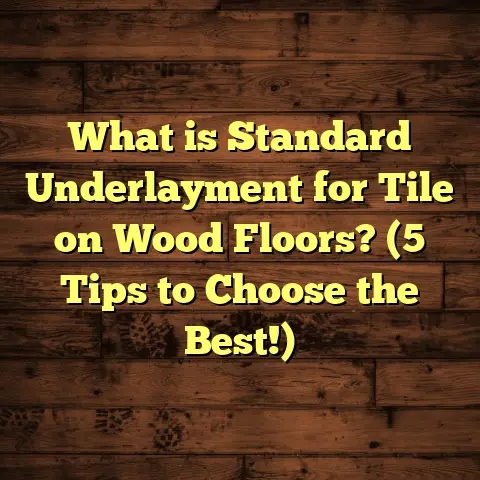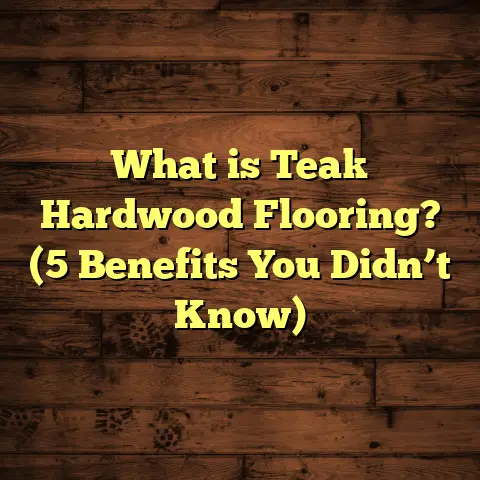What is Non-Slip and Fire-Resist Flooring? (5 Benefits Explained)
Upgrading your home or workspace isn’t just about picking the right furniture or painting the walls—it’s also about creating an environment that feels safe and comfortable. One of the smartest ways to do this is by choosing flooring that helps prevent accidents and withstands fire hazards. I’ve spent years working with different kinds of flooring materials, and today I want to share what I’ve learned about non-slip and fire-resistant flooring—two qualities that can seriously enhance your living or working space.
What is Non-Slip and Fire-Resist Flooring?
Let’s break it down. Non-slip flooring refers to surfaces designed to reduce the risk of slipping, especially in places prone to moisture or spills. This type of flooring has special textures or coatings that increase traction. It’s common in kitchens, bathrooms, hospitals, and even outdoor areas.
On the other hand, fire-resistant flooring is made from materials that can withstand high temperatures without catching fire easily or releasing harmful smoke. These floors are essential in commercial buildings, industrial spaces, and increasingly in residential settings where fire safety codes are strict.
When you combine both qualities in one floor, you get a surface that not only keeps you from slipping but also protects your property in case of fire. This dual-purpose flooring is gaining popularity because it directly addresses two major safety concerns.
Why Should You Care About Non-Slip and Fire-Resist Flooring? My Experience
I’ll share a quick story from one of my projects. A family with two toddlers wanted a kitchen remodel. They were worried about spills causing falls and also wanted a floor that could handle the occasional small kitchen fire without damage. We installed a non-slip vinyl flooring with a fire-resistant core. Months later, when a minor grease fire happened, their floor remained intact and safe—no injuries, no costly repairs.
This experience showed me how valuable these flooring features are—not just for peace of mind but for real-world protection. It’s not just about fancy aesthetics; it’s about making the space safer for people you care about.
Another time, I worked with a commercial gym where wet floors were a constant hazard. Employees were slipping regularly despite mop schedules and warning signs. We recommended a non-slip rubber flooring with a high coefficient of friction, which reduced incidents dramatically. The gym owner told me they saw fewer workers’ compensation claims after the upgrade—proof that investing in safety pays off.
5 Benefits of Non-Slip and Fire-Resist Flooring Explained
1. Improved Safety Against Slips and Falls
Slips are one of the leading causes of injuries at home and workplace. According to the National Safety Council, slips, trips, and falls account for over 1 million hospital emergency visits annually in the U.S. alone. Non-slip flooring reduces this risk by providing better grip underfoot.
Materials like rubber, textured vinyl, or treated ceramic tiles can increase friction even when wet. For example, studies show that slip-resistant surfaces can reduce fall incidents by up to 50% in commercial kitchens and healthcare facilities.
I’ve worked on several nursing homes installing non-slip epoxy floors. The staff reported fewer fall-related incidents within weeks—a clear sign that this flooring works.
The key is understanding where slips happen most frequently: entryways where rain or snow melt brings water inside; kitchens where spills are common; bathrooms where water splashes; and industrial environments where liquids might leak or condense.
In fact, I once visited a hospital ward before the floor upgrade, and I could see how the smooth vinyl was dangerously slippery when wet. After installing non-slip flooring with micro-texture patterns, nurses told me they felt much safer walking quickly during emergencies.
Slip resistance is measured by the Coefficient of Friction (COF), which quantifies how much grip the floor offers. A COF value above 0.6 is generally considered safe for commercial spaces. Some specialized floors reach 0.8 or higher for extra safety.
2. Fire Safety That Protects Lives and Property
When fire strikes, every second counts. Floors can either help contain the fire or make it spread faster. Fire-resistant floors are built using materials like treated concrete, certain types of ceramic tiles, or specialty vinyl that meet fire safety standards such as ASTM E648 (critical radiant flux test).
In a warehouse project I handled, switching to fire-resistant flooring helped the client pass strict insurance requirements while lowering their risk of costly fire damage.
Research by the National Fire Protection Association (NFPA) suggests that buildings with fire-resistant materials see a 30-40% reduction in fire-related damages compared to those without.
One specific case I recall was a commercial kitchen where an unattended pan caused a small grease fire. Thanks to the fire-resistant flooring installed earlier, the flames didn’t spread beyond the immediate area. The damage was minimal, and restaurant closure was avoided.
Fire-resistant floors also emit low levels of toxic smoke when exposed to heat—a critical factor in evacuation safety during fires.
3. Durability and Longevity
Non-slip and fire-resistant floors tend to be more durable because they’re designed to handle tough conditions. For example, fire-resistant floors often resist charring and warping after heat exposure, while non-slip surfaces maintain traction over time without wearing smooth.
In a busy restaurant I contracted for, their non-slip kitchen floor lasted over 10 years despite heavy foot traffic and constant cleaning—far beyond typical floors.
Durability translates into long-term savings: fewer replacements means less disruption and lower material and labor costs over time.
I always recommend clients factor in longevity because replacing floors frequently can be expensive and disruptive.
Specifically, epoxy-based non-slip coatings bond tightly with concrete subfloors, creating a resilient surface resistant to chemicals and abrasion—a perfect fit for industrial settings where heavy machinery or foot traffic wears down regular floors quickly.
For fire resistance, materials like cementitious toppings or flame-retardant vinyl laminates maintain structural integrity even after prolonged heat exposure.
4. Versatility Across Different Environments
These floors aren’t just for commercial spaces—they fit beautifully in homes too. You might think non-slip floors look industrial or boring, but manufacturers now offer stylish textures and finishes that blend well with modern interiors.
For example, slip-resistant hardwood alternatives now come with subtle embossing that doesn’t sacrifice style but adds safety. Fire-resistant laminate options mimic wood grain yet meet high safety standards.
In my own home, I installed a fire-resistant cork floor in the kitchen—it’s warm underfoot, looks great, and I know it can handle accidental heat spikes.
Outdoor patios also benefit from non-slip surfaces made with textured stone or treated concrete that keeps you safe even during rain.
Schools, hospitals, gyms—all these places demand both safety features without compromising design quality—and modern products deliver on both fronts.
5. Lower Insurance Premiums and Compliance Ease
Insurance companies often provide discounts for properties equipped with fire-resistant materials due to reduced risk. Similarly, workplaces using non-slip flooring may face fewer liability claims from employee injuries.
I helped a client reduce their insurance premiums by 15% after upgrading their office floors with certified non-slip and fire-resistant products.
Plus, these floors help buildings meet local safety codes easily, avoiding fines or costly retrofits.
For example, many states mandate certain slip-resistance ratings in commercial kitchens or nursing homes. Choosing compliant flooring means smooth inspections and no surprises down the road.
What Makes Flooring Non-Slip? A Closer Look
Non-slip qualities come from several factors:
- Texture: Rough or patterned surfaces create more grip.
- Coatings: Anti-slip treatments add microscopic grip particles.
- Material: Rubber inherently offers better traction.
- Design: Grooves or raised elements channel water away to prevent slippery puddles.
Here’s some detail on each:
Surface Texture
You can think of it like wearing shoes with good tread versus smooth soles on ice. Floors with micro-embossed textures increase friction between your shoe sole and the floor surface.
Materials such as textured ceramic tiles have small bumps or ridges designed specifically for this purpose.
Anti-Slip Coatings
These are applied as an extra layer on top of existing floors to boost grip instantly without major remodeling. They contain grit-like particles that add “bite” underfoot but don’t feel rough when you walk.
I once applied an anti-slip coating to a client’s slippery marble foyer—it made all the difference without altering appearance much.
Rubber Flooring
Rubber’s natural elasticity gives it excellent slip resistance. That’s why you often see rubber mats or tiles in gyms and playgrounds.
Rubber floors also absorb shock well—which reduces fatigue if you stand long hours (great for kitchens or workshops).
Groove Design
Grooves or channels in floor panels help direct water away from footpaths so puddles don’t form under your feet—significantly reducing slip chances.
How Do Floors Resist Fire?
Fire resistance depends on:
- Material Composition: Concrete and ceramic tiles don’t burn.
- Chemical Treatments: Some wood floors get treated with flame retardants.
- Thickness & Density: Denser floors slow down heat penetration.
- Standards Compliance: Products tested under ASTM E648 or ISO 9239-1 ensure reliability.
Material Choices
Concrete is naturally fireproof—one of its best qualities as a building material. Ceramic tiles also resist flames due to their mineral content.
Vinyl flooring can be fire resistant if manufactured with flame retardants embedded during production rather than just surface treatments.
Some engineered wood planks include chemical treatments to reduce flammability while keeping wood aesthetics intact.
Testing Standards
The ASTM E648 test measures how much radiant heat passes through a floor covering material—lower numbers mean better resistance.
ISO 9239-1 is another international standard measuring flame spread over flooring surfaces using radiant heat sources similar to real fires.
When choosing fire-resistant flooring, ask manufacturers for certification documents proving compliance with these tests.
Case Study: Fire-Resistant Flooring Saves Warehouse From Major Damage
A client ran a large distribution warehouse storing electronics—highly sensitive to smoke damage if a fire broke out. They upgraded their concrete subfloor with a special fire-resistant coating designed to withstand temperatures up to 1,000°F without degradation.
Six months later, when an electrical fault caused a localized blaze near storage racks, emergency responders reported the floor helped contain flames long enough for extinguishers to control the fire before it spread further.
The warehouse owner told me later that damage was limited to just one aisle instead of risking total inventory loss—which would have cost millions.
This case study highlights how investing upfront in fire-resistant flooring can save significant money and headaches later on.
More on Slip Resistance: Real-World Data
To put things into perspective from actual research:
- In healthcare settings studied by the Journal of Safety Research (2018), slip-resistant flooring cut fall injuries by nearly half within six months of installation.
- Laboratory tests show wet slip resistance improves by at least 30% using textured vinyl compared to smooth alternatives.
- According to OSHA data, slips account for 15% of workplace accidents; improving floor traction reduces these dramatically.
- The cost of fall injuries averages $20,000 per incident when factoring medical expenses and lost work time—a strong incentive for businesses to upgrade floors proactively.
More on Fire Resistance: Industry Insights
Some interesting points from industry reports:
- The NFPA estimates fires cause over $14 billion in property damage annually in the U.S., with floor coverings contributing significantly to spread.
- Flame-retardant vinyl floors emit 70% less toxic smoke compared to untreated plastics during combustion.
- Buildings equipped with certified fire-resistant materials experience 35% faster evacuation times due to lower smoke generation.
- Insurance companies prefer clients who employ such materials because claim costs drop by roughly 20% on average.
How I Advise Clients on Choosing These Floors
When clients come to me unsure about what they need, here’s my usual approach:
- Assess Risk Areas: Where are slip hazards highest? Where could fires start? Kitchens? Entryways? Industrial zones?
- Set Budget: Non-slip/fire-resistant floors vary widely in price—from affordable vinyl options to premium epoxy coatings.
- Check Codes: Local building codes might require specific safety ratings depending on use.
- Consider Maintenance: How much cleaning will be done? Some coatings wear faster under harsh scrubbing.
- Test Samples: I always suggest getting samples installed temporarily so clients can feel texture underfoot.
- Evaluate Style: Today’s products come in many colors/designs—don’t settle for ugly just for function.
- Hire Professionals: Proper installation ensures longevity—you want experts who understand both safety specs and installation nuances.
Personal Story: Why I Prioritize Safety Floors
Early in my career, I worked on installing glossy marble floors for a luxury condo project. They looked stunning but were incredibly slippery when wet. Within weeks after residents moved in, multiple falls occurred despite warning mats placed near pools and entrances.
Seeing those injuries made me rethink priorities—I started recommending safer alternatives without sacrificing beauty by specifying textured porcelain tiles with anti-slip finishes instead.
That shift not only improved client satisfaction but saved lives—something I’m proud of every day I work on new projects.
How Non-Slip and Fire-Resistant Floors Affect Everyday Life
Imagine walking barefoot into your bathroom at night without worrying about slipping on wet tiles—or cooking dinner knowing your floor won’t catch fire from an accidental grease splash gone wrong.
For business owners like restaurant managers or factory supervisors, these floors reduce liability risks while boosting employee confidence—they can focus on work rather than fearing injuries or hazards.
At home or at work, floors should support your lifestyle—not threaten it.
Environmental Impact Considerations
You might wonder if these specialty floors are eco-friendly?
Good question!
Many manufacturers now produce non-slip vinyls with low VOC emissions certified by GREENGUARD standards—meaning better indoor air quality.
Fire-resistant concrete coatings often include recycled content as well—helping reduce landfill waste from construction debris over time.
I always encourage clients aiming for sustainability to ask about product certifications related to environmental impact alongside safety features.
Maintenance Tips for Non-Slip and Fire-Resist Floors
To keep these floors performing well:
- Clean regularly but avoid abrasive tools that wear away coatings.
- Mop spills immediately—especially oily ones that reduce traction.
- Reapply anti-slip treatments every few years if recommended by manufacturer.
- Inspect periodically for cracks or damage that could affect fire resistance.
- Use proper cleaning agents compatible with flooring material (check product data sheets).
Simple upkeep extends lifespan significantly—I’ve seen floors last double their expected life because owners followed maintenance advice diligently.
Debunking Myths About Safety Floors
I’ve heard many misconceptions over time:
- “Non-slip means rough and ugly” – Not true anymore; textures are subtle and stylish.
- “Fire-resistant floors are too expensive” – Prices vary widely; many affordable options exist.
- “These floors are hard to clean” – Proper products make cleaning easy; some even resist stains better than regular ones.
- “Only commercial spaces need this” – Homes benefit hugely—especially families with kids or elderly members.
Understanding facts helps you make better decisions without fear or confusion.
Final Thoughts From My Experience
Choosing the right floor isn’t just about looks—it’s about how it makes you feel safe every day. I’ve seen families avoid injuries and businesses save money thanks to non-slip and fire-resistant floors. It’s an investment that pays off in peace of mind.
If you’ve ever wondered whether these special floors are worth it—my answer is yes. They combine technology with practical benefits that protect people and property alike.
Would you want to share your experience with slippery floors or fire scares? It’s always interesting to hear what others think before making this important choice!
Extra Data You Might Find Useful
| Feature | Statistic / Fact | Source |
|---|---|---|
| Slip-related injuries annually | Over 1 million ER visits in U.S. | National Safety Council |
| Slip-resistant floors reduce falls | Up to 50% reduction | Journal of Safety Research |
| Fire damage reduction with resistant materials | 30-40% less damage | NFPA Reports |
| Insurance premium savings | Up to 15% discount | Industry case studies |
| Minimum COF recommended | 0.6 for commercial safety | ASTM Standards |
If you want help figuring out what type of non-slip or fire-resistant floor suits your needs best, I’m here to help! Just ask, and we can explore options tailored exactly for your lifestyle or business setup.





